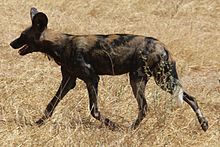
Canidae is a biological family of dog-like carnivorans. A member of this family is called a canid. There are three subfamilies found within the canid family, which are the extinct Borophaginae and Hesperocyoninae, and the extant Caninae. The Caninae are known as canines, and include domestic dogs, wolves, foxes, and other extant and extinct species.

There are 38 subspecies of Canis lupus listed in the taxonomic authority Mammal Species of the World. These subspecies were named over the past 250 years, and since their naming, a number of them have gone extinct. The nominate subspecies is the Eurasian wolf, Canis lupus lupus.

Jackals are medium-sized omnivorous mammals of the subtribe Canina, which also includes wolves and the domestic dog, among other species. While the word "jackal" has historically been used for many small canines, in modern use it most commonly refers to three species: the closely related black-backed jackal and side-striped jackal of sub-Saharan-Africa, and the golden jackal of south-central Europe and Asia.

Gonarezhou National Park is a national park located in south-eastern Zimbabwe. It is situated in a relatively remote corner of Masvingo Province, south of Chimanimani along the Mozambique border. Owing to its vast size, rugged terrain and its location away from main tourist routes, large tracts of Gonarezhou remain as pristine wilderness.
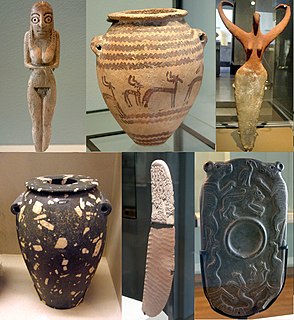
The prehistory of Egypt spans the period from the earliest human settlement to the beginning of the Early Dynastic Period around 3100 BC, starting with the first Pharaoh, Narmer for some Egyptologists, Hor-Aha for others, with the name Menes also possibly used for one of these kings. This Predynastic era is traditionally equivalent to the final part of the Neolithic period beginning c. 6000 BC and ending in the Naqada III period c. 3000 BC.

The side-striped jackal is a canine native to central and southern Africa. Unlike the smaller and related black-backed jackal, which dwells in open plains, the side-striped jackal primarily dwells in woodland and scrub areas.
Canid hybrids are the result of interbreeding between different species of the "true dog" tribe Canini, specifically in the Canina subtribe of wolf-like canids. They often occur in the wild, in particular between domestic or feral dogs and wild native canids.

The Egyptian wolf is a subspecies of African golden wolf native to northern, eastern and a part of western Africa.

Cosmetic palettes are archaeological artifacts, originally used in predynastic Egypt to grind and apply ingredients for facial or body cosmetics. The decorative palettes of the late 4th millennium BCE appear to have lost this function and became commemorative, ornamental, and possibly ceremonial. They were made almost exclusively out of siltstone with a few exceptions. The siltstone originated from quarries in the Wadi Hammamat.
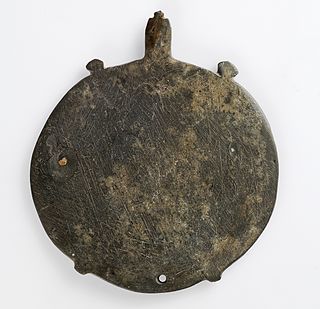
The zoomorphic palette is a type of cosmetic palette made during the predynastic period of Egypt. The palettes are found at burial sites, for example Abydos in the second half of the 4th millennium BC.

The Caninae, known as canines, are one of three subfamilies found within the canid family. The other two canid subfamilies are the extinct Borophaginae and Hesperocyoninae. The Caninae includes all living canids and their most recent fossil relatives. Their fossils were first found in North America and dated to the Oligocene era, then spreading to Asia at the end of the Miocene era, some 7 million to 8 million years ago.
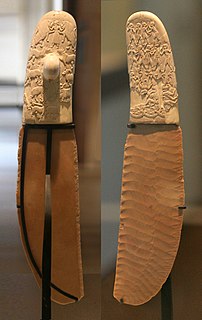
The Gebel el-Arak Knife, also Jebel el-Arak Knife, is an ivory and flint knife dating from the Naqada II period of Egyptian prehistory, showing Mesopotamian influence. The knife was purchased in 1914 in Cairo by Georges Aaron Bénédite for the Louvre, where it is now on display in the Sully wing, room 20. At the time of its purchase, the knife handle was alleged by the seller to have been found at the site of Gebel el-Arak, but it is today believed to come from Abydos.

Xenocyon is an extinct subgenus of Canis. The group includes Canis (Xenocyon) africanus, Canis (Xenocyon) antonii and Canis (Xenocyon) falconeri that gave rise to Canis (Xenocyon) lycanoides. The hypercarnivorous Xenocyon gave rise to the modern dhole and the African wild dog.

The Harenna Forest is located in a highland forest region of the Bale Mountains, in the Oromia Region of southeastern Ethiopia.
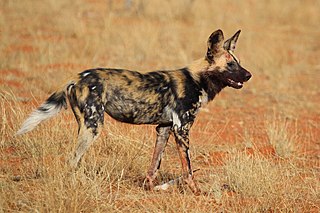
The African wild dog is a canine which is a native species to sub-Saharan Africa. It is the largest wild canine in Africa, and the only extant member of the genus Lycaon, which is distinguished from Canis by dentition highly specialised for a hypercarnivorous diet, and a lack of dewclaws. It is estimated that about 6,600 adults including 1,400 mature individuals live in 39 subpopulations that are all threatened by habitat fragmentation, human persecution and outbreaks of diseases. As the largest subpopulation probably consists of less than 250 individuals, the African wild dog is listed as endangered on the IUCN Red List since 1990.

The Somali wild dog is a subspecies of African wild dog native to the Horn of Africa. It is similar to the East African subspecies, but is smaller, has shorter and coarser fur and has a weaker dentition. Its colour closely approaches that of the Cape subspecies, with the yellow parts being buff, rather than bright orange, as is the case in the East African subspecies.

The Cape wild dog, also known as the South African wild dog, Cape hunting dog, or the painted wolf, is the nominate subspecies of African wild dog native to Southern Africa.
The Chad wild dog, also known as the Shari River hunting dog, the Saharan wild dog or the Central African wild dog, is a subspecies of the African wild dog native to Central Africa.

The African golden wolf or African wolf is a canine native to North Africa, West Africa, the Sahel, northern East Africa, and the Horn of Africa. It is the descendant of a genetically admixed canid of 72% gray wolf and 28% Ethiopian wolf ancestry. It is listed as least concern on the IUCN Red List. In the Atlas Mountains, it was sighted in elevations as high as 1,800 m (5,900 ft). It is primarily a predator, targeting invertebrates and mammals as large as gazelle fawns, though larger animals are sometimes taken. Its diet also includes animal carcasses, human refuse, and fruit. The African golden wolf is a monogamous and territorial species; offspring remain with the family to assist in raising their parents' younger pups.

The West African wild dog is a subspecies of the African wild dog native to West Africa. It is classified as Critically Endangered by IUCN, as it was estimated that 70 adult individuals are left in the wild.
